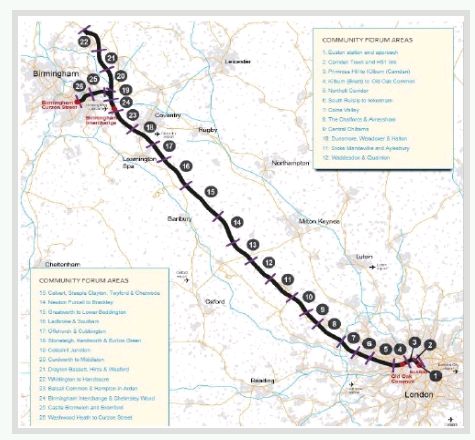Our last blog focussed on the provisions contained within the
Bill itself, but the Bill was deposited amongst a myriad of other
documents which we have so far only touched on.
By far the largest - and the document actually being referred to
when people say the Bill is "50,000 pages long" is the
Environmental Statement (ES). This sets out the impacts which
Government thinks HS2 is likely to have on the environment,
together with proposals for mitigating those impacts. This blog
provides a brief and hopefully helpful overview of the ES and
accompanying documentation, with a brief summary where
appropriate.
1. Guide to the Environmental Statement: Understanding
the HS2 Phase One environmental statement - This document does
not form part of the ES itself but provides a 3 page guide to the
makeup of the ES. Page 2 of the document provides a helpful visual
guide to the structure of the ES, and includes the community forum
area reports (see below) as well as the environmental topics.
2. Non technical summary - a 165
page "user- friendly" summary of the likely signifiant
environmental effects of HS2 Phase 1, both beneficial and adverse,
and the means to avoid or reduce adverse effects. European law
requires ESs to be accompanied by non-technical summaries, and for
most lay readers this is likely to be the best way to get an
overview of the project and its impacts.
3. Glossary and abbreviations
- does what it says on the tin.
4. Volume 1: Introduction to the
Environmental Statement. This volume comprises the following
sections:
- Introduction: introduces the project and its associated consent process, including the hybrid Bill and Environmental Impact Assessment (EIA);
- Background to HS2: explains the Government's case for HS2 and how the project has evolved;
- Approach to consultation and engagement: describes the approach to consultation and engagement for the ES and the process going forward;
- The proposed scheme: provides a summary of HS2's objectives, describes the route, the service pattern and other operational characteristics;
- Permanent features of HS2: describes the main features of the project;
- Construction of the scheme: describes the generic construction methods likely to be used;
- Environmental Impact Assessment: explains how the EIA has been carried out and the scope of the assessment;
- Scope and methodology: provides an outline of the appraisal adopted for each environmental topic;
- Mitigation: describes the proposed mitigation approach for each environmental topic;
- Strategic and route-wide alternatives: provides a summary of the various alternatives that have been considered at a strategic and route-wide level; and
- Local alternatives: explains what local alternatives have been considered prior to January 2012. Local alternatives considered after 2012 are reported in the Volume 2: community forum area reports.
5. Volume 2: Community Forum Area Reports and Map
Books - there are 26 Community Forum Area (CFA) reports and
associated map books which present the likely significant
environmental effects of the proposed scheme within a series of
CFAs along the entire Phase One route:

The Community Forums were established by HS2 Ltd as a way of
"engaging" with the local communities along the route.
Opinion is divided on how effective they've been for that
purpose, but having established the Forums, HS2 Ltd thought it
would be helpful to readers of the ES if it was broken down into
the same CF Areas. The idea is that people will only need to read
the CFA Report for the area in which they are interested, rather
than the whole ES. Each CFA report presents the likely significant
effects of the construction and operation of the proposed scheme on
the environment in that area, as well as the mitigation measures
that are proposed. Each report is accompanied by a map book, which
contains a series of maps relating to the relevant CFA.
6. Volume 3: Route-wide Effects - Some of the
impacts of HS2 will extend over more than one CFA, so this volume
presents the route-wide effects for each topic in the same order as
reported in the CFA reports. There are also three additional
sections which describe the effects on the special landscape
qualities of the Chilterns AONB as a whole; climate; and waste and
material resources. There are a number of topics where no route
wide effects are expected and these are simply introduced and
reasons for the conclusions that no effects are anticipated are
given.
7. Volume 4: Off-route effects - This report
presents those aspects of the construction and operation of HS2
that have the potential to generate significant environmental
effects in locations remote to the route corridor (i.e. effects
which are not covered within the special scope of the CFA reports).
These effects are mostly, but not exclusively, in relation to other
transport infrastructure, for instance the effects of high-speed
trains running on the classic network.
8. Volume 5 - Supporting Information and Planning - This volume
contains a set of documents providing information about third
parties' planning consents, and other supporting information
that applies to several of the other reports within the ES. It is
split further into the following documents:
-
Draft Environmental Statement Consultation Summary Report - Consultation on an early draft of the ES and draft Code of Construction Practice took place for a 56 day (8 week) period from 16 May 2013 until 11 July 2013. This report summarises the consultation findings, and how they feed into the ES itself.
-
Alternatives Report - Part 1 of this report provides a factual and chronological description of the consideration of the alternatives to HS2 which Government considered. It should be noted that the ES is only required to report the alternatives that the promoter considered - not all the other alternatives that might exist. Part 1 covers strategic options, modal alternatives, wider network options, alternative speeds and upgrades to the existing main lines. Part 2 covers the scheme component options: alternative stations, different route options between London and the West Midlands, access to Heathrow Airport, HS1 and depots.
-
Cross Topic Appendix 1: Committed Developments - This document comprises a further series of maps which show developments along the route which have planning permission as at 31 August 2013 and land allocated for development published in adopted development plans as of 31 August 2013. This should be considered in conjunction with the planning data document (see below).
-
Draft Code of Construction Practice - The draft 'Code of construction practice', contains a series of measures and standards of work to be applied by HS2 Ltd and its contractors throughout the construction period of Phase One of HS2. The draft 'Code of construction practice' will evolve and will be amended as necessary following further engagement during the parliamentary process. This will be a key document for those affected by the scheme to keep an eye on, as it will set out the practical steps to be taken by contractors to reduce the impacts of the works.
-
Off-route Effects Supporting Information - This document contains a summary of the environmental information used in the assessment of the off-route effects arising as a result of changes to the existing West Coast Main Line infrastructure between Lichfield and Colwich. This report also contains details of committed consents and development allocations in the area.
-
Planning Data - This appendix presents planning data that has been used to develop two sets of tables covering 'committed development' and 'proposed development'. Committed development consists of planning consents approved as of 31 August 2013 and land allocated for development purposes in adopted development plans as of 31 August 2013 for the purposes of establishing a basis for the future baseline used in the assessment of effects. Proposed development consists of planning applications registered with local planning authorities but not yet determined as of 31 August 2013 and land allocated for development purposes in published development plans that were not yet adopted as of 31 August 2013.
-
Scope and Methodology Report (SMR) - This report (actually made up of 3 separate documents: the report, the summary consultation report and an addendum) outlines the approach taken by HS2 Ltd in carrying out the EIA and compiling the ES. The consultation report summarises the outcome of the consultation on an earlier version of the draft SMR. The Addendum outlines where the methodology presented within the SMR was not followed, for example as a result of changes in legislation or industry best practise.
-
HS2 Phase Two Consultation: Sustainability Statement - This suite of documents (including a non technical summary) consults on how the proposed new high speed railway from the West Midlands to Manchester and Leeds would support objectives for sustainable development. It's not immediately related to the Phase One ES, and may well be overlook by those with more of an interest in Phase Two.
- Wider Effects Report - This report contains an assessment of additional or new significant environmental effects which could result from a change in alignment of the route within the statutory limits of deviation.
9. Volume 5: Environmental Topic Reports and Map book - These
are essentially technical appendices to be read in conjunction with
each of the 26 area reports. They cover agriculture, air quality, climate, community, cultural heritage, ecology,
electromagnetic interference, land quality, landscape and visual
assessment, socio-economics, sound, noise and vibration,
traffic and transport, waste and water resourses. Most then split into
a route-wide methodology, assumptions and assessment report and
then 26 further reports for each CFA, although some, including
climate and electromagnetic interference take different
formats.
Two further assessments have also been submitted which do not form
part of the ES - an Equality Impact Assessment
and a Health Assessment.
Our next blog will look at yet another suite of documents deposited
with the Bill, known as the Environmental Minimum
Requirements.
The content of this article is intended to provide a general guide to the subject matter. Specialist advice should be sought about your specific circumstances.


